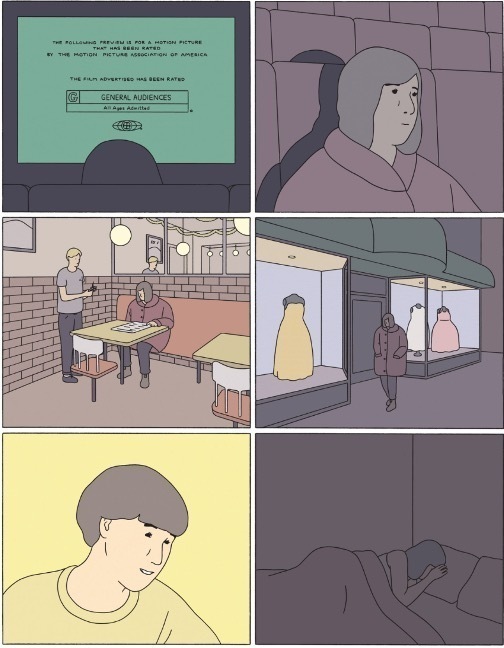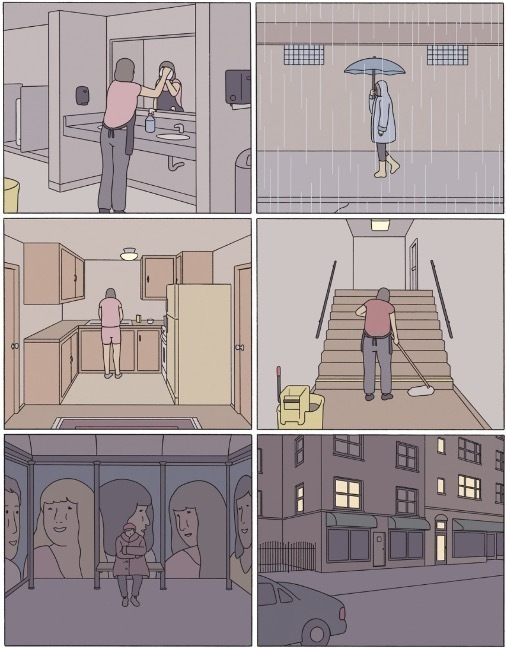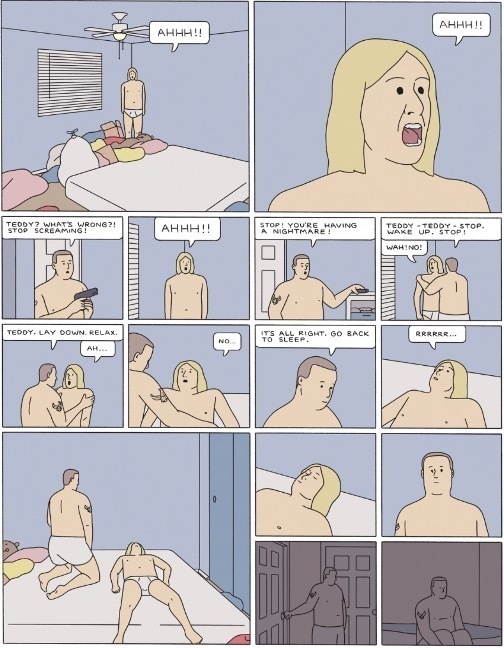Nobody plays the drums for the melody. Scratchy patterns appear on my thighs after hours of sitting in the same position on my carpeted bedroom floor. A pitchy metronome yells at me. I strike the drum. My arms burn. Head rings. The same sound, the same rhythm, the same motion, and the cruel hope that one day, I will be “good.”
Why did I pick the drums and not the melody? Why do I prefer repetitive, lyricless songs? I notice patterns of mundanity in almost every aspect of my life and the lives of others. From the movies we watch to the books we read, a lot of successful media today demonstrates the ever-popular appeal for cyclical, rhythmic presentations of content. While it is easy to believe that surprising media would captivate us most, much popularity is to be found in predictability. Contemporary American society has designed a world where cyclical mundanity is idolized, mimicking the rhythms of the workplace today. Using the work of affect theorists such as Jennifer Doyle and Lauren Berlant as well as my personal experience with the affects of specific texts, in this piece, I shall argue that short, cyclical formal decisions elicit feelings of regularity and mundanity that are universally shared, making it possible to empathize with a lack of emotion. Charles Yu’s science fictional short story, “Standard Loneliness Package,” and Nick Drnaso’s graphic novel, Sabrina, which I study here, follow these cyclical structural patterns that immediately create a relatable sense of mundanity, for monotony — or the lack of emotion — has become an emotion in itself due to the predictable lifestyle of present-day Americans.
Scholars of affect have worked to identify definitions for affect and emotion, highlighting the nuances while looking at various forms of media. Patrick Jagoda, who studies affect in games, defines emotion as “a subjective and personal content that can be fixed via psychological categories and narrativized via biographical and fictional accounts” (202). For Jagoda, affect, on the other hand, is “an experience of intensity that is nonconscious and relational” (202). This immediate affect can identify itself as an emotion once it becomes conscious and able to be categorized. With the nuances so minute, I initially found it difficult to understand why scholars dedicate so much time to specifying definitions of words that could simply be deemed “close enough.” But as art critic Jennifer Doyle writes in her book Hold It Against Me: Difficulty and Emotion in Contemporary Art, the combining of affect and emotion is “where ideology does its most devastating work ... where we come to know the contours of ourselves, our bodies, our sense of soul” (xi). Within his game design practice, Jagoda argues that this sense of self “might help us better understand the ways that games structure . . . practices of play in the early twenty-first century” (202). Transferring this idea to literature, I want to look at how structure across literary genres elicits an affect that may develop into an emotion, ultimately becoming the relational characteristic of art that draws us in time and time again.
Looking specifically at Charles Yu’s narrative science fiction short story, “Standard Loneliness Package,” both abrupt sentence and paragraph structure demand that readers slow down the rate at which they consume the content, creating an affect that imitates the monotony of the nameless protagonist’s life. The most evident way in which this idea can be seen is in the short sentences that characterize the majority of the short story. Combined with the frequent paragraph breaks that create empty space between ideas, readers experience the bland blocks of time spent working just as the protagonist does. In describing the routine of a typical morning at work, the protagonist says, “I’m at a funeral. | Feeling grief. | Someone else’s grief” (Yu 3). The visual space between ideas slows the rate at which readers’ eyes glance from one word to the next, forcing them to sit with the content and fully absorb the miserable weight of the daily routine of the protagonist. The idea of blocked structure is furthered by including a tiny image of an empty square block when dividing sections of the short story. This large visual space and square image emphasizes the choppy nature of the protagonist’s story while also serving as a means of focusing readers’ attention on important concepts within the story. In describing the start-to-finish process of experience the pain of others, the protagonist highlights the one feeling familiar to “anyone who has done this job long enough . . . and even though you know it’s coming, even though are you, in fact, waiting for it, when it comes, it is always still a shock. | Relief” (Yu 6). After this statement, a square block is used to separate this section of the text from the subsequent section, demanding that readers sit with the concept of relief, just as relief is presented to the eagerly waiting protagonist and his coworkers. Even before the concept of relief is presented, commas are used to emphasize the waiting period, slowing the reading pace by adding chunks of unnecessary phrases such as “in fact.” These additional inserted phrases and commas make the readers feel the same impatience and discomfort as the protagonist as he awaits relief.
Pulling from each of these small, structural decisions, the bland, broken nature of the text imitates the mundanity of the protagonist’s life and work life, which ultimately become blurred beyond distinction. As the protagonist ponders on his life desires, he states, “Maybe the problem isn’t that I don’t have a life. Maybe the problem is that I don’t want a life. | I go to work” (Yu 30). A statement about life is followed directly by a statement about work, almost allowing the statement “I go to work” to explain the previous “maybes” wondered by the protagonist without the need for the use of the word “because” in place of the paragraph break. In each structure decision present in the text, the distinction between life of work life is blurred to emphasize the protagonist's dissatisfaction.
In addition to the fragmented nature of the sentence and paragraph structures within “Standard Loneliness Package,” the text also utilizes repetition to blur ideas together, commenting on the indistinct, meaningless days that cumulate to make up the protagonist’s life. For example, the statement “I’m at a funeral” appears repeatedly in the short story. Then, as the story progresses, this statement begins to blur with the other experiences of the protagonist. He narrates, “I am at a funeral. | I am having a hernia. | I am having a hernia at a funeral. | I am in prison. | I’m at the dentist. | I’m at the prison dentist with a hernia” (Yu 26). The tickets become one and the same as all pain is simply just pain to the protagonist. Not only do his tickets blend together, but so do his days: “I am being shot at. | I am being slapped in the face. | I go home. | I rest for a few hours. | I come back and do it again” (28). The predictable nature of pain that clouds the protagonist’s days is an attack on the monotony of a meaningless life.
I first read “Standard Loneliness Package” in a public space. Dozens of individually working students sat motionless around me, captivated by their notebooks and computer screens. For a while I blended in, and then I felt the affect of the words. There was something comforting about the regularity of this text. Sentences felt nostalgic, like I was reading a children’s book from my own childhood; each beat was short and simple. Perhaps this comfort and familiarity could be identified as the text’s affect on me; this is the relationality that Jagoda finds intrinsic to affect (202). As I continued reading and sat with the content of the short story, my connections to the text furthered into what could be the transition from affect to emotion as my experience became more conscious. Looking around the study room, the mundanity of it all mimicked the life of the nameless protagonist, for I did not know any of their names yet there we were together, all soaking up the pain of a university, and a society, that demands perfection and craves profit. Amongst my expressionless peers, I began to cry. I felt trapped and voiceless like the paper mask on my face. Though I am unsure of the exact line between what classified as emotion and what remained affect in this experience of reading “Standard Loneliness Package,” it remains evident that the structure of the text called for this affect and furthered emotion.
Similarly, in Nick Drnaso’s Sabrina, structural decisions are used in the graphic images to display the emotions of the characters, using simplicity and order to portray monotony. Much like how “Standard Loneliness Package” uses short, mundane sentences, simplicity can be seen in Sabrina through the colors and design of each image. Looking specifically at the effect of Sabrina’s murder on Sandra, her sister, we see bland images used to depict her life after Sabrina. In an attempt to feel normal again, Sandra goes about her daily routine, even going out to see a movie or have a meal. As Sandra goes from work to the theater to the bus and back home, we see each graphic become the same size and shape (Dranso 92-94).


The consistency in the design of these graphics puts Sandra’s lack of interest on display. Though there are no words in this scene, I easily saw how Sandra no longer enjoyed seemingly fun activities such as going out to eat, shopping, or watching a movie as a result of the monotonous design. Nevertheless, Sandra maintains her monotonous routine in the hopes of returning to a better life. In addition, each graphic shows images of Sandra from the perspective of an outsider. Even as she views the movie screen, readers can see her head in the image. And as she orders at the restaurant, we view her from the other side of the room as if we are another customer in the restaurant. By making each graphic display an outside view of Sandra, the text portrays Sandra's depression following the loss of her sister.

Another character in Sabrina in which formal decisions are used to portray difficult affects is Teddy, Sabrina’s boyfriend. Similar to how “Standard Loneliness Package” uses repetitive phrases to blur experiences, Sabrina distorts the representation of time by intentionally confusing the order of images. Following a nightmare about Sabrina, Teddy wakes up shouting in panic. Calvin runs into the room. The scene is filled with small square images (Dranso 46). Because there are larger images on this page as well, the text makes it difficult for the reader to understand which order I was supposed to read in. Regardless of what order I chose, the idea of panic is still clearly depicted. The small, jumbled graphics portray the chaos of the scene for both Teddy after his nightmare and Calvin as he rapidly attempts to console his friend. This same technique is used to display the life of Teddy continuously throughout the text. Especially toward the middle of the novel, Teddy spends the majority of his time wandering around Calvin’s home. He even avoids wearing clothing and sleeps on a coverless mattress, creating an affect of emptiness. As he walks around and plays with the toys in Cici’s room, small images show his movements while larger graphics show images of Sabrina (Drnaso 87). The effect of this ordering shows that no matter what Teddy does with his day, Sabrina is always on his mind. He becomes lost in the monotony of his daily life, lacking no specific routine, only reliving his grief each moment. The cyclical, small graphics and the simplicity of it all transfer Teddy’s sense of purposelessness to readers as each page becomes a blur of time and events.
I read Sabrina in my car, doors locked. The yellow light above me lit up the images despite the intense darkness of the sky. Perhaps it was the sense of safety I had in my car, but the dark murder story did not make me feel nervous. There was a sense of comfort in the text, and it captivated my attention. I was reluctant to even drive home, for that would require me to put down the book. The images, though mundane, created a world in which I felt I was a part. And with Sabrina being my first graphic novel, I felt the familiarity of childhood picture books once again. Perhaps this comfort and familiarity from Sabrina is the novel’s affect on me as much of my captivation was unconscious. I did not realize how dark it was getting outside when I needed to turn the overhead lights on. However, the affect of Sabrina did stick with me long enough to become conscious as I recommended the novel for my dad to read, describing the beauty and familiarity of the graphic images and the story they tell. Though the distinction between affect and emotion remains partially unclear in my personal experience of reading Sabrina, both display the miserable beauty of the novel. Sabrina made me crave monotony. I could not put monotony down.
By closely looking at the emotion and affect of formal decisions in both “Standard Loneliness Package” and Sabrina, it becomes clear that similar techniques can be used to portray the same affects regardless of genre. The short, simple sentences of “Standard Loneliness Package” have the same affect as the simple, bland graphics in Sabrina. Both create a sense of mundanity that clouds the character’s lives, pulling readers closer into the story. The repetition of phrases in “Standard Loneliness Package” is similar to the confusing order of the small graphics in Sabrina as they both distort time to emphasize the characters’ struggles to remain engaged in the purposeless lives they are surrounded by.
What about a mundane text makes it so captivating? Affect theorists view each text as having its own distinct “mood conveyed to a reader or audience member . . . that serves to contextualize the events and situations that foster more punctual emotional episodes” (Hogan). Mood may seem like a simple literary phenomenon, but the “most important thing to recognize here is that moods are often complex, the result of a number of distinct emotional sensitivities, such that the resulting inclinations are a matter of networks of emotion” (Hogan). Both “Standard Loneliness Package” and Sabrina pull from a variety of less distinct feelings, making the connection between affect and emotion more complicated. While the texts may seem to elicit a lack of response, being regular and simple in their presentation of ideas and events, they portray monotony, or the lack of emotion, as an emotion within itself. It is worth noting that monotony could perhaps be argued to be an affect rather than an emotion. However, the identification of monotony is elicited through additional ambiguous feeling; the frequent overlap and indistinct lines separating emotions is what allows multiple interpretations of affect from one person to the next. This specific kind of ambivalent emotion is one that deserves to be further explored.
The ambiguous nature of monotonous emotion allows each reader to interpret the content in which it originates from through their own personal lens. One specific technique of this nature in which both texts utilize is eliciting personal memories from readers. Out of the “three sources of emotional system activation: innate sensitivities, critical period experiences, and emotional memories,” both texts focus on emotional memories, or “memories that, upon activation, revive the initial emotion itself” (Hogan). By pulling from our own memories of a mundane life in contemporary American society, a simple graphic portraying a lonely day or a sentence about emotionally demanding work is enough to remind readers of our own shared pain. Art critic Jennifer Doyle argues that emotion and affect should be seen “as a means not of narcissistic escape but of social engagement” (xi). It is this social engagement, this shared structure of feeling, to use literary critic Raymond William’s term, that allows for monotony to become such an integral part of contemporary media forms (“structures of feeling”). And since this mundanity hurts us, it, in all its messiness, appears as an emotion.
In the American version of late capitalism, we glorify endless workdays, prioritize career success over personal growth, and view vulnerable emotions as weakness rather than human nature. Monotony and regularity of work has been a critical component of industrial and post-industrial capitalism. It stands to reason, then, that such regularity has created forms of cultural production that generate and elicit specifically correlated emotions. The idea of monotonous promoting emotion presents itself as a paradox, just like Lauren Berlant’s idea of cruel optimism. She defines this form of optimism as existing when “something you desire is actually an obstacle to your flourishing. It might involve food, or a kind of love; it might be a fantasy of the good life” (Berlant 1). She argues that what you desire to be happy is actually holding you back. It is a great explanation for how the protagonist in “Standard Loneliness Package” works the same painful job every day in the hopes of being able to afford a better life. This desire keeps him trapped in his painful job that will never truly lead him to the standard happiness package he desires. Also, in Sabrina, Sandra maintains her monotonous, depressing routine in an attempt to feel better after the loss of Sabrina. This again is an example of cruel optimism because this routine will never lead her to happiness. Eventually, Sandra does learn that change will help her to recover, so she ventures on the bike ride that she used to talk about with Sabrina. Our contemporary world embraces many cruel optimisms, especially the idea of “the good life.” Cruel optimism is held in monotony, preaching, “Do not dance in the rain. Endure it. Dance later.” But that’s not how time works. Like the repeating sentences of the protagonist in “Standard Loneliness Package,” and the thoughtful ordering of familiar graphics in Sabrina, time is cyclical, structured, and predictable. True optimism is learning to embrace the inevitable rain. And then maybe the next short, repetitive, over-stated sentence will be a better one.
Mundanity is our newest emotion, one that traps us in the lives we choose with the intent of reaching “the good life.” This idea is reflected across all genres and forms of the media we consume, as structure and form present affects and eventually emotions that remind us of our toughest societal struggles. We see ourselves in the miserable, robotic pain of Charles Yu’s protagonist as he gets thrown around by his corporation. We see ourselves in the small images of life that blur together and lose the understanding of the reader in Nick Drnaso’s Sabrina. In a world of cruel cycles, monotony enchants us.
Works Cited
Berlant, Lauren Gail. Cruel Optimism. Duke University Press, 2012.
Doyle, Jennifer. Hold It Against Me: Difficulty and Emotion in Contemporary Art. Duke University Press, 2013.
Drnaso, Nick. Sabrina. Drawn & Quarterly, 2018.
Hogan, Patrick Colm. Affect Studies. Oxford Research Encyclopedias, 31 Aug. 2016, https://doi.org/10.1093/acrefore/9780190201098.013.105.
Jagoda, Patrick. On Difficulty in Video Games: Mechanics, Interpretation, Affect. The University of Chicago, 2018.
“structures of feeling.” Oxford Reference, https://www.oxfordreference.com/view/10.1093/oi/authority.20110803100538488
Yu, Charles. “Standard Loneliness Package.” Sorry, Please, Thank You, Vintage Books, New York, 2013.

